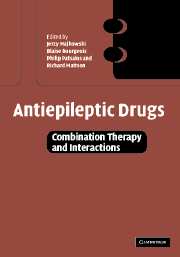Book contents
- Frontmatter
- Contents
- List of contributors
- Foreword
- Foreword
- Acknowledgements
- Part I Introduction
- Part II Pharmacokinetic interactions
- Part III Pharmacodynamic interactions
- Part IV Drug interactions in specific patient populations and special conditions
- 14 Antiepileptic drug interactions in children
- 15 Antiepileptic drug interactions in the elderly
- 16 Antiepileptic drug interactions in pregnancy
- 17 Antiepileptic drug interactions in handicapped and mentally retarded patients
- 18 Antiepileptic drugs and sex steroids
- 19 Antiepileptic drug interactions in patients requiring psychiatric drug treatment
- 20 Antiepileptic drugs in non-epileptic health conditions: possible interactions
- 21 Drug monitoring in combination therapy
- 22 Cognitive side-effects due to antiepileptic drug combinations and interactions
- Part V Conclusions and future perspectives
- Index
18 - Antiepileptic drugs and sex steroids
from Part IV - Drug interactions in specific patient populations and special conditions
Published online by Cambridge University Press: 07 September 2009
- Frontmatter
- Contents
- List of contributors
- Foreword
- Foreword
- Acknowledgements
- Part I Introduction
- Part II Pharmacokinetic interactions
- Part III Pharmacodynamic interactions
- Part IV Drug interactions in specific patient populations and special conditions
- 14 Antiepileptic drug interactions in children
- 15 Antiepileptic drug interactions in the elderly
- 16 Antiepileptic drug interactions in pregnancy
- 17 Antiepileptic drug interactions in handicapped and mentally retarded patients
- 18 Antiepileptic drugs and sex steroids
- 19 Antiepileptic drug interactions in patients requiring psychiatric drug treatment
- 20 Antiepileptic drugs in non-epileptic health conditions: possible interactions
- 21 Drug monitoring in combination therapy
- 22 Cognitive side-effects due to antiepileptic drug combinations and interactions
- Part V Conclusions and future perspectives
- Index
Summary
Background
In 1972 Kenyon sent a letter to the British Medical Journal describing a patient with epilepsy treated with phenytoin (PHT) who became pregnant despite taking usual amounts of oral contraceptive (OC) pills (Kenyon, 1972). She astutely attributed the contraceptive failure to an inductive effect of the PHT on the metabolism of the sex steroid hormones. This observation was soon confirmed by others (Coulam and Annegers, 1979; Janz and Schmidt, 1974) and the underlying mechanisms were further elucidated (Back, 1980). All the older antiepileptic drugs (AEDs), carbamazepine (CBZ), phenobarbital (PB), PHT and primidone (PRM) except valproate (VPA) (Crawford 1986; Sonnen, 1983) were found to have similar effects (Mattson et al., 1986; Schmidt, 1981). In contrast most of the new AEDs with the exception of felbamate (FBM), oxcarbazepine (OXC) and topiramate (TPM) do not change the metabolism of the OCs. Parenteral formulations (intramuscular (i.m.) depot, subcutaneous implant and dermal patch) of contraceptive female sex hormones have also been reported to be subject to increased clearance.
The effect of the AEDs on testosterone metabolism has also indicated changes occur although the evidence of clinical effects is less easily assessed than an unplanned pregnancy. Conversely, except for lamotrigine (LTG) the OCs do not appear to change the pharmacokinetics of AEDs.
Frequency and importance of interactions
Following the initial case report by Kenyon, three other cases of OC failure were cited by Janz and Schmidt (1974). By 1983 Sonnen found that 52 cases had been reported.
Keywords
- Type
- Chapter
- Information
- Antiepileptic DrugsCombination Therapy and Interactions, pp. 341 - 349Publisher: Cambridge University PressPrint publication year: 2005



